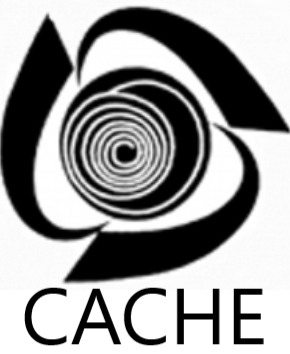Enzyme Kinetics: Screencasts
Derives the rate expression for an enzyme reaction with a substrate to make a product using the rate-determining step approximation.
We suggest that after watching this screencast, you list the important points as a way to increase retention.
Describes the three types if inhibition of enzyme reactions: competitive, noncompetitive, uncompetitive.
We suggest that after watching this screencast, you list the important points as a way to increase retention.
Important Equations:
Enzyme reactions with no inhibition
\(E\, +\,S\, \xrightarrow{\text{\(k_1\)}} \, E \cdot S\) (1)
\(E \cdot S \, \xrightarrow{\text{\(k_2\)}} \, E\, + \,S\) (2)
\(E \cdot S \, \xrightarrow{\text{\(k_3\)}} \, P\, + \,E\) (3)
\(E\) = enzyme, \(S\) = substrate (i.e., reactant), \(E \cdot S\) = enzyme-substrate complex, \(P\) = reaction products
The rate of consumption of substrate (\(-r_s\)) = rate of formation of products (\(r_p\))
Michaelis-Menten equation
\(r_p = -r_s = \dfrac{k_3[E_t][S]}{[S] + K_M} = \dfrac{V_{max} [S]}{[S] + K_M}\) (a)
where \([S]\) = substrate concentration
\([E_t]\) = total enzyme concentration = \([E] + [E \cdot S]\)
\([E]\) = concentration of enzyme
\([E \cdot S]\) = concentration of enzyme-substrate
\(K_M = \dfrac{k_2}{k_1}\) = Michaelis-Menten constant
\(V_{max} = k_3 [E_t]\) = maximum rate of reaction
A linear plot is obtained by inverting eqn. (a) to yield the Lineweaver-Burke equation
\(\dfrac{1}{-r_s} = \dfrac{1}{V_{max}} + \dfrac{K_M}{V_{max} [S]}\) (b)
A plot of \(\dfrac{1}{-r_s}\) versus \(\dfrac{1}{[S]}\) is a straight line with an intercept of \(\dfrac{1}{V_{max}}\) and a slope of \(\dfrac{K_M}{V_{max}}\).
Although a linear plot can be obtained, nonlinear regression may be a better way to measure enzyme kinetic parameters (M. Marasovic, T. Marasovic, M. Milos, Robust Nonlinear Regression in Enzyme Kinetic Parameters Estimation, Journal of Chemistry, Vol 2017, Article ID 6560983.)
Enzyme reactions with competitive inhibition
\(E\, +\,S\, \xrightarrow{\text{\(k_1\)}} \, E \cdot S\) (1)
\(E \cdot S \, \xrightarrow{\text{\(k_2\)}} \, E\, + \,S\) (2)
\(E \cdot S \, \xrightarrow{\text{\(k_3\)}} \, P\, + \,E\) (3)
\(I\, +\,E\, \xrightarrow{\text{\(k_4\)}} \, E \cdot I\) (inactive) (4)
\(E \cdot I \, \xrightarrow{\text{\(k_5\)}} \, E\, + \,I\) (5)
\(I\) = inhibitor, \(E \cdot I\) = enzyme-inhibitor complex
\([E \cdot I]\) = concentration of an enzyme-inhibitor complex
\(-r_s = r_p = \dfrac{V_{max}[S]}{[S]+K_M\left(1+\dfrac{[I]}{K_I}\right)}\) (c)
\(-\dfrac{1}{r_s} = \dfrac{1}{[S]} \dfrac{K_M}{V_{max}} \left( 1 + \dfrac{[I]}{K_I} \right) + \dfrac{1}{V_{max}}\) (d)
where \([I]\) = inhibitor concentration
\([E \cdot I]\) = concentration of enzyme-inhibitor complex
\([E_t]\) = total enzyme concentration = \([E] + [E \cdot S] + [E \cdot I]\)
\([K_I] = \dfrac{k_5}{k_4}\) = inhibition constant
A plot of \(\dfrac{1}{-r_s}\) versus \(\dfrac{1}{[S]}\) is a straight line with an intercept of \(\dfrac{1}{V_{max}}\) and a slope of \(\dfrac{K_M}{V_{max}} \left(1 + \dfrac{[I]}{K_I}\right)\).
Enzyme reactions with uncompetitive (anti-competitive) inhibition: The inhibitor binds to the enzyme-substrate complex forming an inhibitor-enzyme-substrate complex.
\(E\, +\,S\, \xrightarrow{\text{\(k_1\)}} \, E \cdot S\) (1)
\(E \cdot S \, \xrightarrow{\text{\(k_2\)}} \, E\, + \,S\) (2)
\(E \cdot S \, \xrightarrow{\text{\(k_3\)}} \, P\, + \,E\) (3)
\(I\, +\,E \cdot S\, \xrightarrow{\text{\(k_6\)}} \, I \cdot E \cdot S\) (inactive) (6)
\(I \cdot E \cdot S \, \xrightarrow{\text{\(k_7\)}} \, I\, + \,E \cdot S\) (7)
where \(I \cdot E \cdot S\) = complex with both \(I\) and \(S\) bound to \(E\)
\(-r_s = r_p = \dfrac{V_{max}[S]}{K_M+[S]\left(1+\dfrac{[I]}{K_I}\right)}\) (e)
\(-\dfrac{1}{r_s} = \dfrac{1}{[S]} \left( \dfrac{K_M}{V_{max}} \right) + \dfrac{1}{V_{max}} \left( 1 + \dfrac{[I]}{K_I} \right) \) (f)
where \(K_I = \dfrac{k_7}{k_6}\)
A plot of \(\dfrac{1}{-r_s}\) versus \(\dfrac{1}{[S]}\) is a straight line with an intercept of \(\dfrac{1}{V_{max}} \left( 1 + \dfrac{[I]}{K_I} \right)\) and a slope of \(\dfrac{K_M}{V_{max}}\).
\([E_t]\) = total enzyme concentration = \([E] + [E \cdot S] + [I \cdot E \cdot S]\)
Enzyme reactions with noncompetitive (mixed) inhibition: The inhibitor can bind to the enzyme or enzyme-substrate complex. The substrate can also bind to the inhibitor-enzyme complex.
\(E\, +\,S\, \xrightarrow{\text{\(k_1\)}} \, E \cdot S\) (1)
\(E \cdot S \, \xrightarrow{\text{\(k_2\)}} \, E\, + \,S\) (2)
\(E \cdot S \, \xrightarrow{\text{\(k_3\)}} \, P\, + \,E\) (3)
\(I\, +\,E\, \xrightarrow{\text{\(k_4\)}} \, E \cdot I\) (inactive) (4)
\(E \cdot I \, \xrightarrow{\text{\(k_5\)}} \, E\, + \,I\) (5)
\(I\, +\,E \cdot S\, \xrightarrow{\text{\(k_8\)}} \, I \cdot E \cdot S\) (inactive) (8)
\(I \cdot E \cdot S \, \xrightarrow{\text{\(k_9\)}} \, I\, + \,E \cdot S\) (9)
\(S + I \cdot E \, \xrightarrow{\text{\(k_{10}\)}} \, I \cdot \,E \cdot S\) (inactive) (10)
\(I \cdot E \cdot S \, \xrightarrow{\text{\(k_{11}\)}} \,S + I \cdot E\) (11)
where \(K_I = \frac{k_5}{k_4} = \frac{k_9}{k_8}\) \(K_M = \frac{k_2}{k_1} = \frac{k_{11}}{k_{10}}\)
\(-r_s = r_p = \dfrac{V_{max}[S]}{(K_M+[S])\left(1+\dfrac{[I]}{K_I}\right)}\) (g)
\(-\dfrac{1}{r_s} = \dfrac{1}{[S]} \left( \dfrac{K_M}{V_{max}} \right) \left( 1 + \dfrac{[I]}{K_I} \right) + \dfrac{1}{V_{max}} \left( 1 + \dfrac{[I]}{K_I} \right)\) (h)
A plot of \(\dfrac{1}{-r_s}\) versus \(\dfrac{1}{[S]}\) is a straight line with an intercept of \(\dfrac{1}{V_{max}} \left(1 + \dfrac{[I]}{K_I} \right)\) and a slope of \(\dfrac{K_M}{V_{max}} \left(1 + \dfrac{[I]}{K_I} \right)\).
Substrate inhibition: The substrate reacts with an enzyme-substrate complex to form an inactive substrate-enzyme-substrate complex.
\(E\, +\,S\, \xrightarrow{\text{\(k_1\)}} \, E \cdot S\) (1)
\(E \cdot S \, \xrightarrow{\text{\(k_2\)}} \, E\, + \,S\) (2)
\(E \cdot S \, \xrightarrow{\text{\(k_3\)}} \, P\, + \,E\) (3)
\(S\, +\,E \cdot S\, \xrightarrow{\text{\(k_{12}\)}} \, S \cdot E \cdot S\) (inactive) (12)
\(S \cdot E \cdot S \, \xrightarrow{\text{\(k_{13}\)}} \, S\, + \,E \cdot S\) (13)
\(-r_s = r_p = \dfrac{V_{max} [S]}{\left( K_M + [S] + \dfrac{[S]^2}{K_I} \right)}\) (i)
\(-\dfrac{1}{r_s} = \dfrac{1}{[S]} \left( \dfrac{K_M}{V_{max}} \right) + \dfrac{1}{V_{max}} \left( 1 + \dfrac{[S]}{K_I} \right)\) (j)
where \(K_I = \dfrac{k_{13}}{k_{12}}\)
This plot is not linear because the y-intercept depends on the substrate concentration \([S]\).


